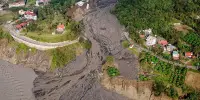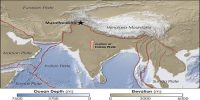This was the first time a humpback whale was recorded on the river and the story made international headlines. In recent days, a whale has been spotted near the river bank and scientists are watching it closely.
Contrary to its name, the river is full of crocodiles, not spices. And its shallow water has no place for a bus-sized whale. In recent months, three humpback whales have been spotted on the East Alligator River in the Kakadu National Park in the Northern Territory.
The whale’s strange path raised many questions. How did they end up in the river? What will they eat? Will they get stuck in the mud riverbank? And of course, there was a big question that kept asking me: Which animal can win a fight between a crocodile and a humpback whale?
Scientist’s double-take
Recent environmentalist Jason Fowler and co-scientists first spotted humpback whales in September this year during a fishing trip. Fowler told ABC:
I noticed a big spout, a big hit on the horizon and I thought it was a big dolphin… we were going crazy with what we were actually seeing with each other. After four hours of intense debate, we agreed that we were looking for humpback whales in a river.
The whales were swimming about 20 kilometers upstream. As proof of the fowler, the humpback whale took pictures of the dorsal fin and reported this unusual sighting to authorities and scientists.
Thankfully, the two whales returned to the sea by themselves, only one needed help. The concern was that it might be trapped in a shallow, awful tidal wave. If this happens, the crocodiles can attack – in another minute.
These include physical disabilities such as nets or boats and the sound of deadly whales – known hunters of the humpback whale. Experts considered various strategies to encourage whales to return to the sea. But none of these options were needed. 17 days later, the last whale swam back into the sea by itself.
It seems to have lost weight – probably the result of immigration. It is now being closely monitored in the Van Diemen Gulf region.
The whale, which had been in the river for two weeks, recently returned and was seen swimming around the mouth of the river.
The animal’s health is now in question and why it did not move south toward Antarctic feeding waters.
So why were whales in the river?
There are various theories as to why they were swimming in the Eastern Alligator River. Humpback whales are extremely curious and have entered the river to explore the area.
Whales are part of the humpback whale population off the west coast of Australia, which travels every year from cold drinking water outside Antarctica to warm waters for Kimberley breeding.
Alternatively, they’ve made a mistake on navigation – also a possible reason why the September pilot whales in Tasmania lag behind in mass.
And the big question – what about the crocs?
Humpback whales are incredibly powerful animals. A flick of their large tail will often be enough to send the crocodile away. In this case, my bet would fall on the whale – if it is in relatively good condition and can swim well.
Long-term, pre-obligator Rivers reduce the chances of a Humpback whale surviving. Low levels of salinity can lead to skin problems and they may be trapped
















